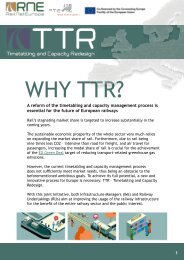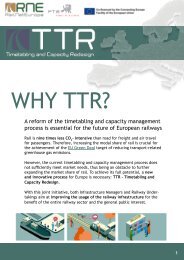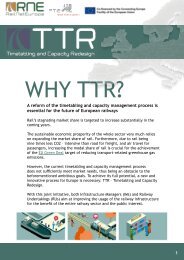TTR_Extended_Brochure_2023
Create successful ePaper yourself
Turn your PDF publications into a flip-book with our unique Google optimized e-Paper software.
COMMERCIAL<br />
CONDITIONS<br />
To encourage stakeholders<br />
to use the process and capacity<br />
products as efficiently as possible,<br />
certain commercial conditions<br />
must be agreed and applied to<br />
avoid loss of capacity and ensure<br />
consistency across borders<br />
at European level.<br />
P<br />
PA<br />
PA<br />
P<br />
ATH MODIFICAT<br />
A<br />
ION<br />
L<br />
ATH ALT<br />
A<br />
ERAT<br />
ION<br />
CA<br />
C<br />
HARMONIZED<br />
COMMERCIAL<br />
CONDITIONS<br />
NCELLA<br />
L<br />
ATION (IM)<br />
CANCELLAT<br />
(APPLICANT)<br />
A<br />
NON- USAGE OF PA<br />
ION<br />
ATH<br />
P<br />
Rail capacity is wasted, mainly due to<br />
• capacity blocked but eventually not used by RU stakeholders<br />
• constantly changing planning parameters (both RU and IM)<br />
Commercial Conditions shall steer the behaviour of stakeholders towards making<br />
the best use of available capacity on the rail network.<br />
The following process elements require steering through commercial conditions:<br />
Path modification,<br />
cancellation and non-usage<br />
by Applicant<br />
due to commercial or operational<br />
needs<br />
Path alteration<br />
and cancellation by IM<br />
in connection with TCRs<br />
(late TCRs, changes in planned TCRs)<br />
Commercial Conditions are part of the focused projects to find consensus<br />
among IMs and RUs.








